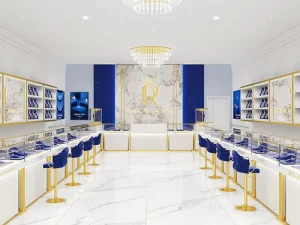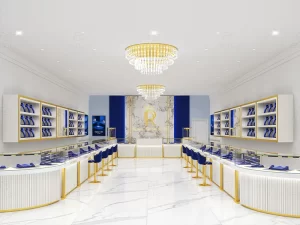
How Much Does It Cost to Open a Jewelry Store?
Jewelry is one of the most popular and profitable retail categories, as it appeals to a wide range of customers and occasions. Whether you sell fine jewelry or fashion jewelry, handmade jewelry or branded jewelry, you can tap into a huge market of jewelry lovers and buyers.
But how much does it cost to open a jewelry store? What are the main expenses and investments that you need to consider? And how can you reduce your costs and increase your profits? In this article, we will answer these questions and more, to help you plan and budget for your jewelry business.
The Main Costs of Opening a Jewelry Store
The cost of opening a jewelry store can vary depending on many factors, such as your location, size, type, quality, and style of your store. However, according to various sources, the average cost of opening a jewelry store in the US is between $20,000 and $100,000. Here is a breakdown of the main costs that you need to consider:
Related:how to open a jewelry store
Key cost breakdowns
These costs may vary depending on your specific situation and requirements. Therefore, it is advisable to research the laws and regulations in your area before you start your business.
| Item | Cost Range |
| Rent | $1000 – $10000 |
| Overhead | $500 – $5000 |
| Inventory | $500 to $50,000 |
| Equipment | $1,000 to $10,000 |
| Marketing | $500 to $5,000 |
| Legal | $100 to $1,000 |
| Total | $3600 – $81,000. |
– Rent: This is the cost of leasing or buying a space for your store. The rent can range from $0 (if you operate from your home or online) to $10,000 per month (if you rent a large storefront in a high-traffic or upscale area). The rent can also vary depending on the length and terms of your lease agreement, and the condition and amenities of your space.
– Overhead: This is the cost of running and maintaining your store, such as utilities, taxes, insurance, security, and cleaning. The overhead can range from $500 to $5,000 per month, depending on the size and location of your store, and the services and providers that you use.
– Inventory: This is the cost of buying or making your jewelry products, such as raw materials, supplies, tools, and packaging. The inventory can range from $500 to $50,000 or more, depending on the type and quality of your jewelry, and the quantity and variety that you offer.
– Equipment: This is the cost of buying or renting the equipment and furniture that you need for your store, such as display cases, shelves, racks, counters, chairs, tables, mirrors, cash register, credit card terminal, receipt printer, barcode scanner, POS system, security cameras, safes, etc. The equipment can range from $1,000 to $10,000 or more, depending on the quality and quantity that you need.
– Marketing: This is the cost of promoting and advertising your store and products, such as website, social media, email, blog, online and offline ads, flyers, brochures, business cards, banners, signs, events, etc. The marketing can range from $500 to $5,000 or more, depending on the strategies and channels that you use, and the frequency and reach of your campaigns.
– Legal: This is the cost of registering and licensing your business, such as business name, legal structure, EIN, sales tax permit, business license, zoning permit, etc. The legal can range from $100 to $1,000 or more, depending on your state and local requirements, and the fees and taxes that you need to pay.

How to Reduce Your Costs and Increase Your Profits
If you want to reduce your costs and increase your profits as a jewelry store owner, there are some tips and tricks that you can follow, such as:
– Choose your location wisely: You should choose a location that suits your target market, your budget, and your goals. You don’t want to pay too much for a space that is too big or too fancy for your needs, or too little for a space that is too small or too shabby for your customers. You should also consider the traffic, competition, and demand in your area, and negotiate the best price and terms for your lease or purchase.
– Optimize your inventory management: You should manage your inventory in a way that balances supply and demand, and avoids overstocking or understocking. You should also monitor your inventory levels, turnover, and shrinkage, and adjust them as needed. You should also source your products from reputable and reliable suppliers, and negotiate the best prices and terms for your purchases. You should also look for ways to save on your raw materials, supplies, tools, and packaging, such as by buying in bulk, using recycled or eco-friendly materials, or making your own products.
– Implement effective marketing and sales strategies: You should implement effective marketing and sales strategies to increase your exposure, promotion, and conversion. You should consider the following techniques
– Online marketing: You should create and maintain a website, social media accounts, email list, and blog, and use them to showcase your products, share your story, and engage with your customers. You should also use online advertising, such as Google Ads, Facebook Ads, or Instagram Ads, to reach your target audience and drive traffic to your website or store.
– Offline marketing: You should use offline marketing, such as flyers, brochures, business cards, banners, and signs, to spread the word about your jewelry store and attract customers. You should also use offline advertising, such as radio, TV, or newspaper ads, to reach a wider audience and increase your brand awareness. You should also participate in or host offline events, such as trade shows, fairs, or parties, to network with potential customers and partners, and to showcase your products and services.
– Upselling: You should use upselling, which is the technique of selling a more expensive or upgraded product or service to your existing customers, to increase your average order value and revenue. For example, you can offer a more expensive or higher quality jewelry piece, or a warranty or insurance plan, to your customers who are buying a jewelry piece from you.
– Cross-selling: You should use cross-selling, which is the technique of selling a complementary or related product or service to your existing customers, to increase your average order value and revenue. For example, you can offer a matching or coordinating jewelry piece, or a jewelry box or cleaner, to your customers who are buying a jewelry piece from you.
– Bundling: You should use bundling, which is the technique of selling a group of products or services together at a lower price than if they were sold separately, to increase your sales volume and revenue. For example, you can offer a set of jewelry pieces, or a jewelry piece and a gift card, to your customers who are looking for a gift or a treat for themselves.
– Discounting: You should use discounting, which is the technique of offering a lower price or a special deal for your products or services, to increase your sales volume and revenue. For example, you can offer a percentage off, a dollar off, a buy one get one free, or a free shipping, to your customers who are looking for a bargain or a incentive to buy.
Manage your finances and operations efficiently: You should manage your finances and operations efficiently to reduce your costs and increase your profitability and cash flow. You should consider the following practices:
– Accounting and bookkeeping: You should keep track of your income and expenses, and record them in a timely and accurate manner. You should also prepare and review your financial statements, such as income statement, balance sheet, and cash flow statement, on a regular basis, and use them to analyze your financial performance and health. You can use online tools, such as [QuickBooks], [FreshBooks], or [Wave], to help you with your accounting and bookkeeping.
– Inventory management: You should manage your inventory in a way that balances supply and demand, and avoids overstocking or understocking. You should also monitor your inventory levels, turnover, and shrinkage, and adjust them as needed. You can use online tools, such as [Shopify], [Square], or [Inventory Source], to help you with your inventory management.
– Cost control: You should control your costs and expenses, and eliminate or reduce any unnecessary or wasteful spending. You should also negotiate with your suppliers, vendors, and service providers, and seek the best prices and terms for your purchases. You should also look for ways to save on your rent, utilities, taxes, and insurance, such as by sharing space, switching providers, or applying for exemptions or discounts.
– Cash flow management: You should manage your cash flow in a way that ensures that you have enough cash to cover your operating expenses, debt payments, and investments. You should also forecast your cash flow, and plan for any shortfalls or surpluses. You should also look for ways to increase your cash inflow, such as by increasing your sales, collecting your receivables, or selling your assets, and to decrease your cash outflow, such as by delaying your payables, reducing your inventory, or refinancing your debt.
Conclusion
The cost of opening a jewelry store can vary depending on many factors, but the average cost is between $20,000 and $100,000. However, the cost is not the only factor that determines the success and profitability of a jewelry store. You also need to consider your location, inventory, equipment, marketing, sales, management, and operation, and how to optimize them to reduce your costs and increase your profits. You can find and compare the best prices and deals for your equipment and supplies online, through platforms such as [Amazon], [eBay], or [AliExpress], or offline, through local suppliers, wholesalers, or distributors.
Share:
Table of Contents
Shop Fixtures Manufacturer
We are a manufacturer of display products established in 1995 in Guangzhou, China. We specialize in a wide range of retail store fixtures,including display case,showcase,racks,counters,stands , etc. Providing customers with one-stop merchandising solutions.
Recent Posts
Subscribe to Newsletter
Get all the latest information on shop design ideas, sales and offers. Subscribe to the newsletter:


This Post Has 2 Comments
Pingback: How to Open a Jewelry Store: A Step-by-Step Guide - Penbo Display
Pingback: How Much Do Jewelry Store Owners Make? - Penbo Display
Comments are closed.